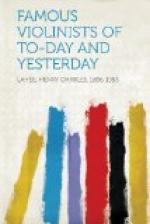In regard to his playing, his technical proficiency was such as very few violinists have ever attained to. His double stopping was perfect, his staccato, both upward and downward, of the utmost brilliancy, and though he cannot be considered a serious musician in the highest sense of the word, he played with warm and poetical, if somewhat sentimental, feeling. He has often been described as the “flaxen-haired Paganini,” and his style was to a great extent influenced by Paganini, but only so far as technicalities are concerned. In every other respect there was a wide difference, for while Paganini’s manner was such as to induce his hearers to believe that they were under the spell of a demon, Ole Bull took his hearers to the dreamy moonlit regions of the North. It is this power of conveying a highly poetic charm which enabled him to fascinate his audiences, and it is a power far beyond any mere trickster or charlatan. He was frequently condemned by the critics for playing popular airs, which indeed formed his greatest attraction for the masses of the people. He seldom played the most serious music, in fact, he confined himself almost entirely to his own compositions, most of which were of a nature to meet the demand of his American audiences.
When Ole Bull played in Boston in 1852, after having been absent for several years, during which time other violinists had been heard, John S. Dwight wrote of his performance thus: “We are wearied and confused by any music, however strongly tinged with any national or individual spirit, however expressive in detail, skilful in execution, and original or bold, or intense in feeling, if it does not at the same time impress us by its unity as a whole, by its development from first to last of one or more pregnant themes. As compositions, therefore, we do not feel reconciled to what Ole Bull seems fond of playing.... He cannot be judged by the usual standards, his genius is exceptional, intensely individual in all its forms and methods, belongs to the very extreme of the romantic as distinguished from the classical in art. He makes use of the violin and of the orchestra, in short of music, simply and mainly to impress his own personal moods, his own personal experience, upon the audiences. You go to hear Ole Bull, rather than to hear and feel his music. It is eminently a personal matter.... Considered simply as an executive power, he seems, after hearing so many good violinists for years past, to exceed them all—always excepting Henri Vieuxtemps.”
It may be said with truth that Ole Bull achieved his reputation at a time when it was comparatively easy to do so. There was very little musical cultivation in this country when he first appeared here, as may be easily imagined by a glance at the extracts from criticisms, given here and there. By his strong personality, apparent mastery of his instrument, and by being practically the sole occupant of the field, he became famous and popular. He prided himself




